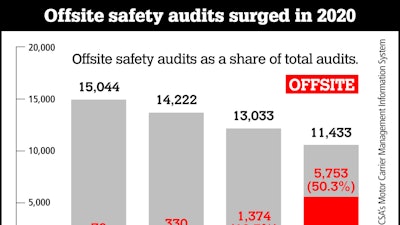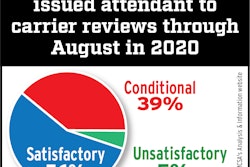 Though the total number of safety audits of motor carriers fell again last year on an annual basis, the number of audits conducted offsite soared to more than half of all audits.
Though the total number of safety audits of motor carriers fell again last year on an annual basis, the number of audits conducted offsite soared to more than half of all audits.
In a trend that exploded amid the COVID-19 pandemic over the past year, the U.S. Department of Transportation and its state enforcement partners are continuing to leverage new authority to perform offsite, remote safety audits and compliance reviews of trucking companies in lieu of onsite, in-person audits, as was the norm before the pandemic.
More than 80% of all audits conducted by DOT and state partners last year were of motor carriers with 20 or fewer trucks, according to DOT data. And more than half, 53.6%, were of carriers with six trucks or fewer.
Those percentages from 2020 are in line with prior years’ breakdown of motor carrier compliance reviews by fleet size. However, the number that were conducted offsite skyrocketed last year -- from 1,374 offsite audits (10.5% of the total number conducted last year) to 5,753, or 50.3% of the 11,433 total audits performed by DOT and state partners last year.
The spike in offsite audits is even more pronounced as compared to 2018 and 2017 -- when just 2% and 0.5% of safety audits, respectively, were conducted remotely.

Lesley Sachs, a partner at the transportation-focused law firm Taylor & Associates, watched the spike occur last year and has been helping carriers navigate the review process. She says that, even if and when the pandemic subsides, the trend toward offsite compliance reviews is likely here to stay.
“FMCSA was putting this infrastructure in place and testing [offsite audits] even before the COVID pandemic,” she said. The need for physical distancing amid the pandemic “presented an ideal time,” she said, for the agency to turn to offsite reviews as a primary tool in its kit. “If the tool is working, they’ll continue to use it beyond COVID.”
As Overdrive reported in August, the Federal Motor Carrier Safety Administration is leveraging new authority as part of the federal government’s COVID-19 response, which allowed FMCSA to issue carriers safety ratings (Satisfactory, Conditional, Unsatisfactory) via remote audits, rather than having to use onsite audits to alter a carrier’s rating.
Enforcers are still leveraging CSA scores to target motor carriers for safety audits, said Sachs. “It’s a good reminder for everyone that they need to be vigilant about paying attention to violations. And when you have them, put in corrective actions to stop it from becoming a trend, because those violations will draw attention if you’re selected for an audit.”
Likewise, carriers should put an emphasis on being organized in case they come under scrutiny by enforcers. “It’s a fast-moving process,” Sachs said. “They typically wrap up in a week to two weeks, and there’s not much wiggle room.”
Operators should be ready to produce requested documents and files within 48 hours if they’re contacted for an offsite audit, she said. That will include company information and background files, and a sample of driver logs and vehicle files, accident records, and roadside inspections.
The question of whether new off-site audit authorities might have resulted in more safety ratings, too, was explored the following month at this link.









